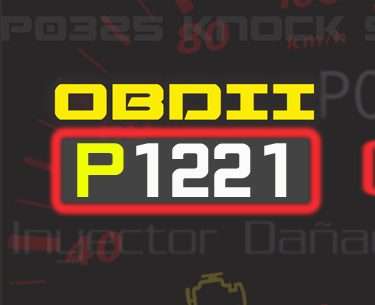
P1221 (Volkswagen, Audi, Skoda, Seat) Exhaust valves for cylinder deactivation - short circuit to ground
Content
P1221 – OBD-II Trouble Code Technical Description
Trouble code P1221 indicates a short to ground in the exhaust valve circuit for cylinder shutdown in Volkswagen, Audi, Skoda, Seat vehicles.
What does the fault code mean P1221?
Trouble code P1221 indicates a problem with the exhaust valve circuit to deactivate the cylinders. The engine management system may temporarily disable certain cylinders to improve fuel economy or reduce emissions. When code P1221 occurs, it means that the exhaust valve control circuit has a short to ground. This may cause the cylinder deactivation system to not function properly, which may result in rough running of the engine, loss of power, or poor fuel efficiency.

Possible reasons
Several possible reasons for the P1221 trouble code:
- Wiring damage: Damage to the wiring connecting the engine control module (ECU) to the exhaust control valves can cause a short to ground and cause code P1221.
- Short circuit in the circuit: A short to ground in the circuit that supplies power to the control valves can occur due to damaged wiring, faulty connectors, or other electrical problems.
- Control valve malfunction: The control valve itself may be faulty, causing the exhaust valve control system to malfunction and causing code P1221 to appear.
- Problems with the engine control module (ECU): Faults in the engine control module can lead to incorrect processing of signals from sensors and incorrect control of control valves.
- Corrosion or oxidation of contacts: Accumulation of corrosion or oxidation of contacts in connectors or connector blocks can also lead to poor contact and a short to ground in the circuit.
These reasons can cause P1221, either alone or in combination with each other. To accurately determine the cause, it is necessary to diagnose the engine control system using specialized equipment.
What are the symptoms of a fault code? P1221?
Symptoms for DTC P1221 may vary depending on the specific situation and engine type:
- Power Loss: One of the most common symptoms is loss of engine power. Improper operation of the exhaust valve control system can cause the cylinders to operate unevenly, resulting in reduced engine performance and power.
- Unstable idle: Improper operation of the exhaust control valves can cause the engine to idle rough. This may manifest itself as a shaking or jerking engine when idling.
- Unusual sounds from the exhaust system: Improper operation of the control valves can cause unusual noises from the exhaust system, such as knocking or popping noises, especially when power is reduced or engine speed changes.
- Increased fuel consumption: Improper operation of the control system may result in inefficient fuel combustion, which may result in increased fuel consumption. This occurs due to the need to compensate for loss of power or uneven operation of the engine.
- Check Engine Indicator: The appearance of the Check Engine light on your car's dashboard is one of the most obvious signs of a problem. If code P1221 is activated, it indicates a problem in the exhaust valve control system.
If you notice any of the above symptoms, it is recommended that you contact a qualified mechanic for diagnosis and repair.
How to diagnose a fault code P1221?
The following steps are recommended to diagnose DTC P1221:
- Scanning error codes: Using a diagnostic scan tool, perform an engine management system scan to identify all trouble codes, including P1221. This will help identify problem areas and components.
- Wiring check: Check the condition of the wiring connecting the engine control unit (ECU) to the exhaust control valves. Make sure the wiring is not damaged, broken or shorted.
- Checking control valves: Check the condition of the exhaust valve control valves. Make sure they work correctly and do not bind, and that the connections are not damaged.
- Checking the engine control module (ECU): Check the engine control module for malfunctions or errors in its operation. This may include testing the software and hardware of the module.
- Checking electrical connections: Check electrical connections, including connectors and pins, to ensure connections are secure and free of corrosion.
- Additional tests: If necessary, perform additional tests, such as checking the exhaust system pressure or checking the operation of other engine management system components.
After diagnosing and identifying the cause of the malfunction, make the necessary repairs or replace damaged components. If you are unable to diagnose it yourself, it is recommended that you contact a qualified auto mechanic or an authorized service center.
Diagnostic errors
When diagnosing DTC P1221, the following errors may occur:
- Skipping basic steps: One common mistake is skipping basic diagnostic steps, such as checking wiring, control valves, and the engine control module. Skipping these steps may result in the cause of the problem being incorrectly determined.
- Misinterpretation of data: Incorrect interpretation of the data obtained during the diagnostic process may lead to an incorrect interpretation of the cause of the malfunction. For example, incorrectly identifying the cause of a short circuit can lead to unnecessary component replacement.
- Faulty equipment: Using faulty or uncalibrated diagnostic equipment can also lead to errors. For example, incorrect results may be obtained due to a faulty multimeter or scanner.
- Insufficient check: Failure to sufficiently check all possible causes may result in missing factors that contribute to DTC P1221. For example, ignoring possible problems with control valves or not fully examining electrical connections.
To avoid these errors, it is important to follow diagnostic standards, conduct a complete and systematic inspection, and use quality and calibrated equipment.
How serious is the fault code? P1221?
Trouble code P1221 should be considered serious because it indicates a problem with the exhaust valve control circuit, which is an important part of the engine management system. Malfunctions in this system can seriously affect engine operation and performance, several reasons why code P1221 is considered serious:
- Loss of power and efficiency: Improper operation of the exhaust valve control circuit can cause the engine to run rough and cause loss of power. This may affect the vehicle's ability to accelerate, climb hills, and maintain speed.
- Unstable engine operation: A malfunction in the control circuit can cause the engine to become unstable, manifested by shaking or jerking when idling or driving. This may create discomfort for the driver and passengers.
- Increased fuel consumption: Improper operation of control valves can result in inefficient combustion of fuel, which will increase fuel consumption and operating costs for the vehicle owner.
- Engine damage: If the control circuit problem is not resolved in a timely manner, it may cause damage to the engine itself due to uneven fuel combustion or excessive stress on engine components.
Overall, the P1221 trouble code requires immediate attention and diagnosis to identify and correct the problem to keep the engine running safely and efficiently.
What repairs will resolve the P1221 code?
Resolving trouble code P1221 may require several possible actions, depending on the specific cause of the problem, some of them are:
- Checking and repairing wiring: Check the condition of the wiring connecting the engine control module to the exhaust control valves. If any damage or broken wiring is found, replace or repair the damaged sections.
- Replacing control valves: If the control valves are found to be faulty, replace them with new or remanufactured ones. Make sure connections are installed correctly and are tight.
- Checking and servicing the engine control module (ECU): Check the engine control module for malfunctions or errors in its operation. This may include testing the software and hardware of the module. If necessary, firmware or replacement of the control module may be required.
- Cleaning and maintaining electrical connections: Check the condition of the connectors and contacts of the electrical connections, make sure they are clean and free of corrosion. Poor connections can cause the system to malfunction.
- Diagnostics and repair of additional components: If necessary, perform additional diagnostics and repairs on other engine management system components, such as sensors, EGR valves, and others. This may help rule out other possible causes of the problem.
It is recommended that the engine management system be diagnosed using specialized equipment to pinpoint the cause of the problem and perform appropriate repairs or replacement of faulty components. If you do not have experience or skill in auto repair, it is recommended that you contact an experienced mechanic or an authorized service center.

